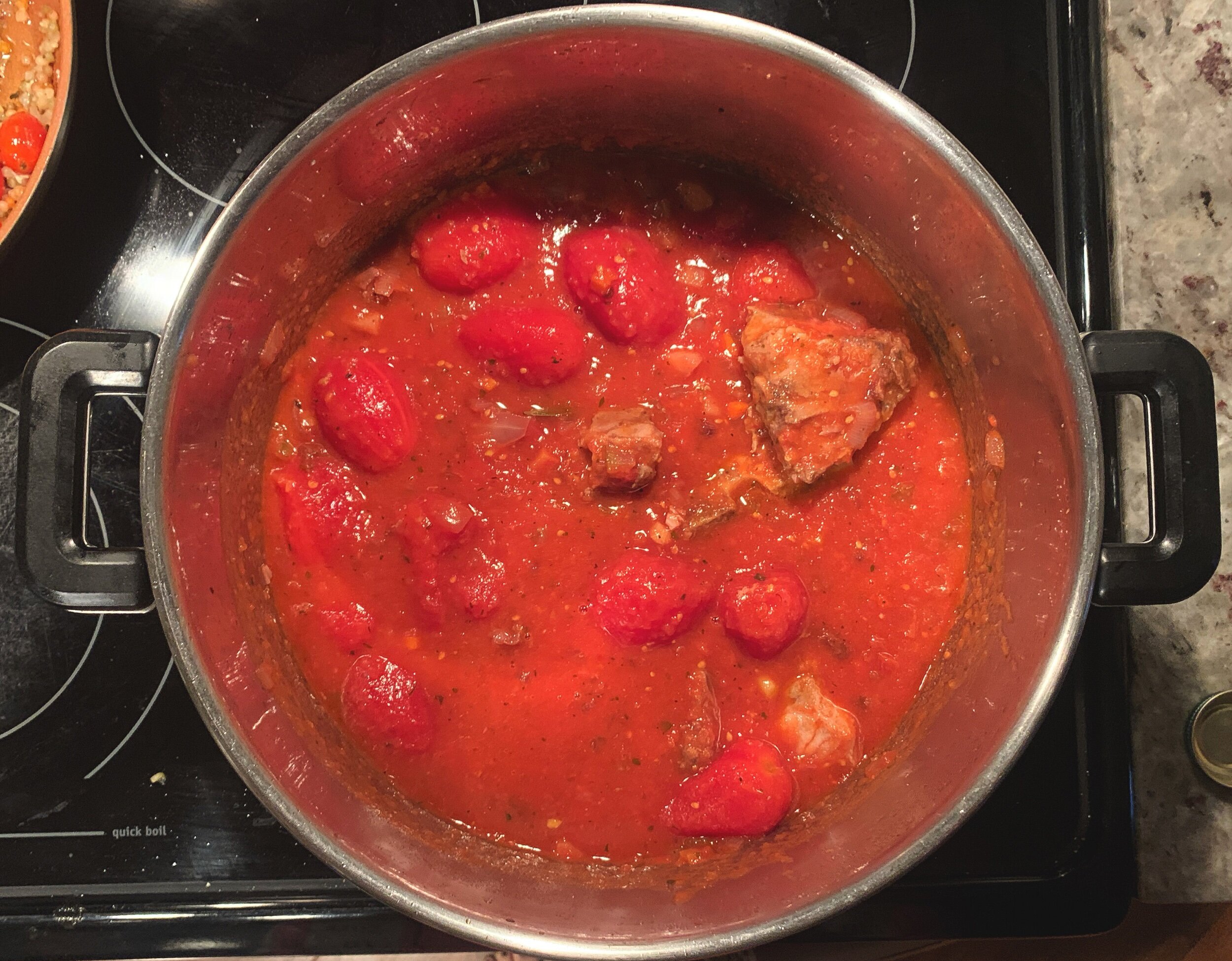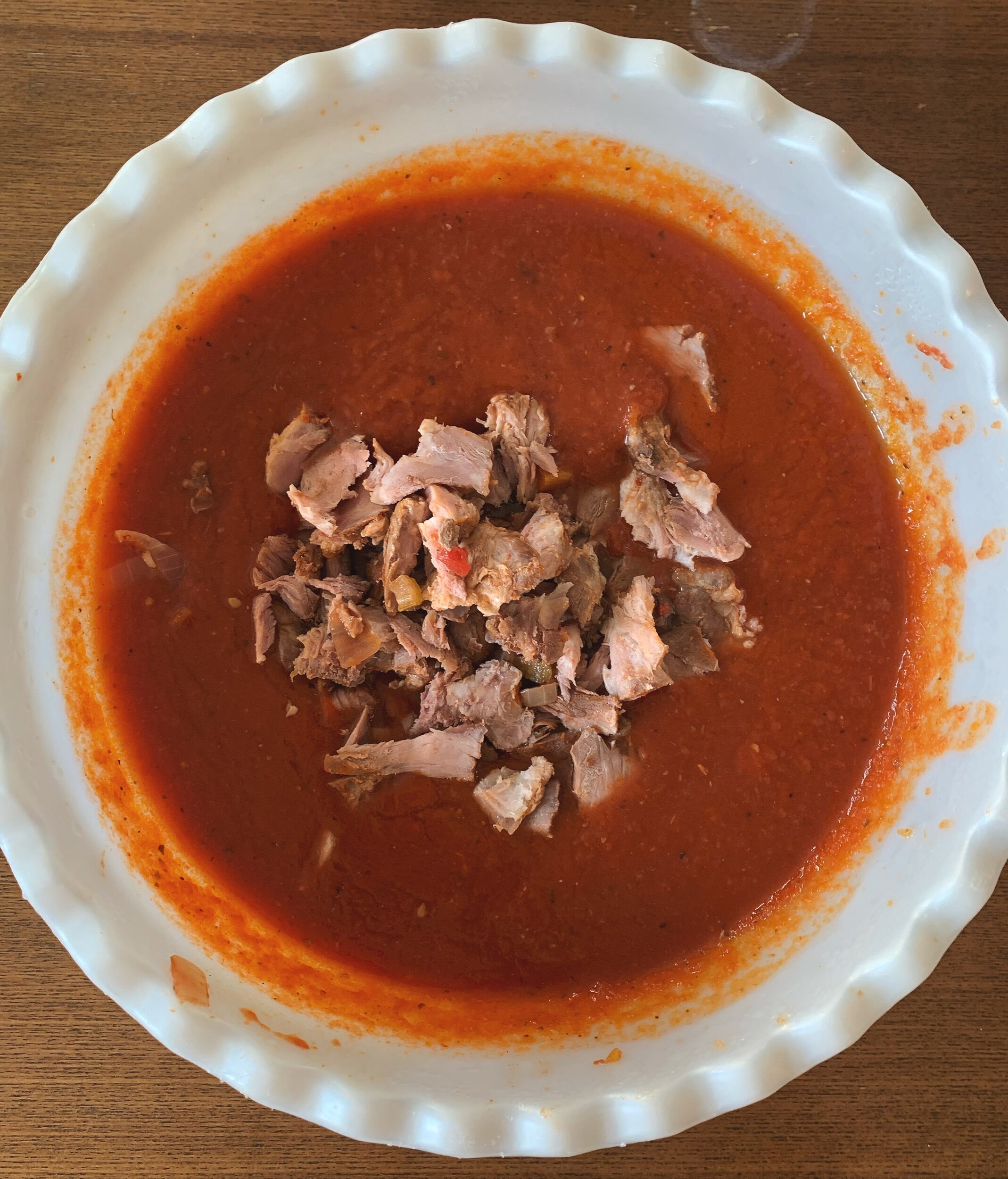Italian Gravy
Yields: About 3.5 quarts
Time: Prep 20 minutes, Cooks 3 hours
Otherwise known as red or tomato sauce, gravy is an Italian-American name for a tomato sauce made from a base of sautéed veggies and some type of meat. Not to be confused with a ragú, this gravy uses the fat from seared pork neck bones to sauté carrots, onion, and celery. The bones are then added back in to the tomatoes and left to braise for several hours. This method packs the sauce with umami, balancing out the natural sweetness of the tomatoes. Use this sauce for pasta, braising, lasagnas, or anything you’d add tomato sauce to! My favorite? Just a big bowl of sauce and a massive hunk of ciabatta! Delizioso!
Ingredients:
1 lb. pork neck bones
4, 28oz. cans of San Marzano tomatoes
Olive oil
Unsalted butter
Carrot
Onion
Celery
Garlic
Kosher salt
Black pepper
Red pepper flakes
Bay leaves
Tomato paste
Red wine vinegar
Dry red wine
Dried and fresh parsley
Dried and fresh basil
Special Equipment:
Large stock pot
Directions
Step One:
In a large stock pot, heat a few tablespoons of olive oil over high heat. Once oil is shimmering, sear pork neck bones for 5-6 minutes on each side or until they are browned and caramelized.
Step Two:
While pork is searing, dice one whole yellow onion and about 1 cup each of celery and carrot. Roughly chop 3-4 large cloves of garlic, set aside.
Step Three:
Remove pork from pot and set aside. Reduce heat to medium, add a few tablespoons of butter and another swig of olive oil to the stock pot. Using a wooden spoon, scrape up any brown bits from the pork. Sauté onion, carrot, and celery for 5-7 minutes until onion is translucent. Season to taste with salt and pepper. Add in garlic and sauté for another 2-3 minutes.
Step Four:
Stir 2 tablespoons of tomato paste into veggies until thoroughly combined. Add 2-3 bay leaves and red pepper flakes to taste. Cook until tomato paste has become fragrant, another 2-3 minutes.
Step Five:
Turn heat to medium-high and add a couple capfuls of red wine vinegar. Pour in just enough dry red wine to cover the veggies, 1.5-2 cups. Stir and cook until wine is reduced by about half.
Step Six:
Drain the excess liquid from two of the four cans of tomatoes. Blend those two cans of tomatoes in a blender until smooth. Add the two blended cans and two whole cans to the stock pot. Season to taste with salt, pepper, dried parsley and dried basil. Add pork neck bones back into stock pot and mix thoroughly. Reduce heat to low and simmer sauce for 3 hours, stirring occasionally. Cover with lid slightly askew to release steam.
Step Seven:
After three hours, remove all pork and bay leaves from sauce. Discard bay leaves. Taste one last time for seasoning but it should be perfect at this point.
Place food mill over a large mixing bowl. Working in batches, ladle in a few scoops of sauce and mill until all liquid has passed through. The mill will fill with the skins and fibers of the veggies and you’ll be left with a silky, luscious sauce. (Hot tip, save those skins and fibers for your compost!)
Step Eight (Optional):
Remove meat from the bones of the pork using a paring knife (or your fingers). Shred into bite size pieces and add meat to sauce. If you prefer to skip this step that’s fine! The pork neck bones make a great snack on their own.
Step Nine:
Whichever way you choose to use this sauce, always add a palm full each of freshly chopped parsley and basil right before you serve. Adding the fresh herbs at the very end will preserve the integrity of their flavor and add a brightness to the sauce.
Gravy can be refrigerated for about a week and frozen for up to six months.
Marinara v. Gravy
The most common mistake people make with tomato sauce is equating gravy with marinara. Marinara is a specific sauce both in its ingredients and its origin. Marinara comes from marinai, the Italian word for ‘sailor’. This sauce orginates from southern Italian sailors after the 16th century. The sailors would need simple, filling, and healthy meals while out at sea. Basic ingredients like tomatoes, olive oil, garlic and (probably dried) herbs made for the perfect sauce. Not only were they easy ingredients to come by but they also had a shelf life that would last on long journeys. To me, the best marinara’s are made with only those simple ingredients: whole tomatoes, garlic, extra virgin olive oil, and fresh basil.







